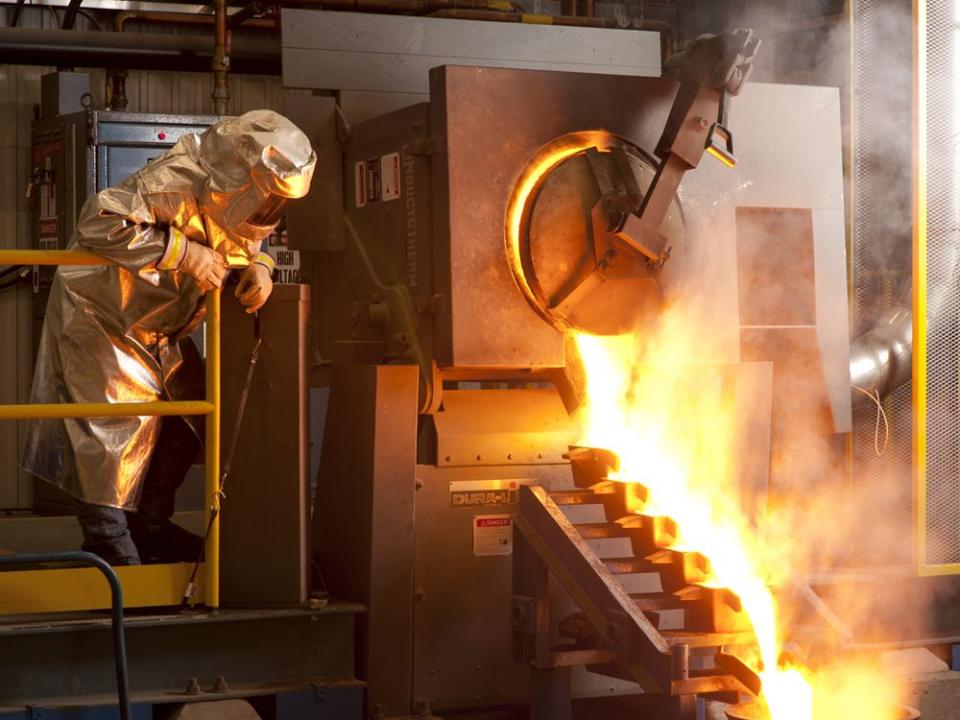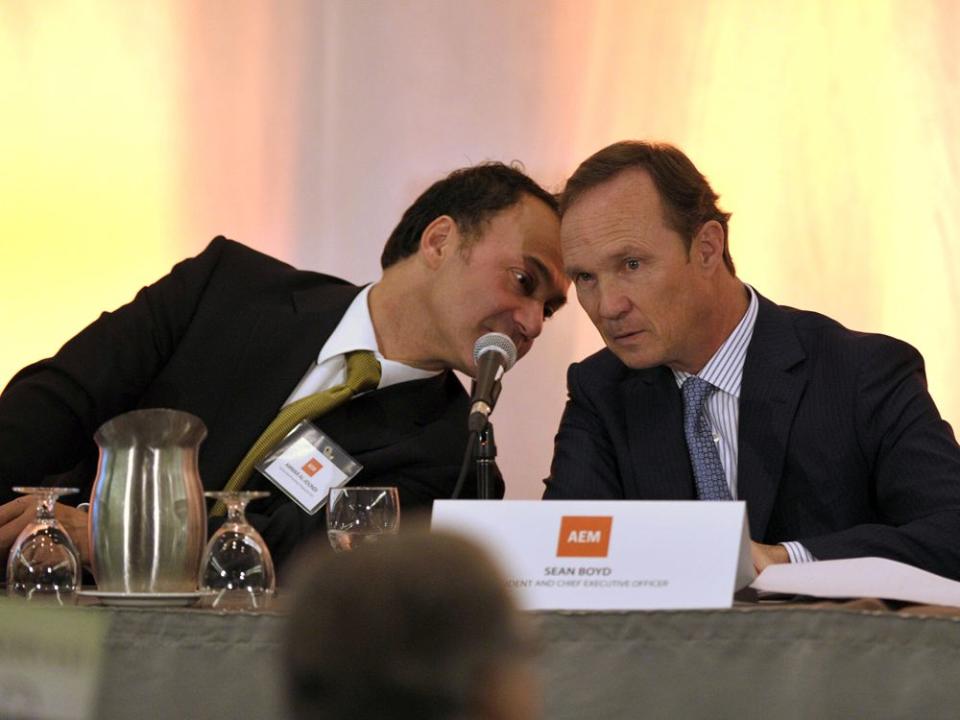Agnico CEO talks short-term funds, diversification and how gold miners succeed

Toronto-based Agnico Eagle Mines Ltd. reported its fourth quarter earnings on Feb. 17 and noted that inflation was causing its costs to inch upward.
The world’s third-largest gold producer also produced slightly less gold than expected and its shares dropped 7.84 per cent to $45.44.
“We did a lot of very good things that controlled costs, but we’re not immune from inflation forever,” chief executive Ammar Al-Joundi said Feb. 17 during an earnings call with analysts. “What you’re seeing in the fourth quarter is some of that affecting us.”
The following is a transcript of a conversation between the Financial Post’s Gabriel Friedman and Al-Joundi. It has been lightly edited for clarity and brevity.
Financial Post: Looking at your fourth quarter results, the inflationary pressures out there, but also the consolidation happening — Newmont Corp. wants to buy Newcrest Mining Ltd. — what do you see as the the most important factors affecting gold mining companies’ share prices?
Al-Joundi: I think investors in gold mining stocks are transitioning from being resource funds to generalist funds and that’s because, frankly, resource funds haven’t been able to get that much money. If you take a look at the size of the gold industry, it’s tiny relative to the generalist investor funds available. What I really believe is that Agnico’s not competing with other gold mining companies for investors. Rather, we as an industry are competing with other industries — tech, bioscience, telecom, manufacturing. For our industry to be competitive, we have to generate value and be seen as a good business rather than just a gold business.
We have to generate value and be seen as a good business rather than just a gold business
Ammar Al-Joundi
With regards to consolidation, we are very supportive of consolidation in the industry as long as it’s smart and as long as there’s a path to actually create value through it. You know, we merged with Kirkland Lake Gold Ltd. and we’re acquiring the other half of Canadian Malartic from Yamana Gold Inc. There are going to be synergies but the real value added and the reason we’re doing this is because we think we can generate a lot more value by consolidating these regions.
A very simple example: if you take Canadian Malartic, we paid a fair price for the mine, but we also got huge exploration potential and a lot of excess mill capacity that’s going to become available. Nobody else in the world can utilize that excess mill capacity as well as we can because we have a lot of assets nearby that can actually use it. We think there’s a potential to add another 500,000 ounces a year of production later this decade.
FP: Several months ago, you said that Agnico is studying how to ramp up production at its Detour mine in Ontario to one million ounces per year. Is that still a possibility?
Al-Joundi: Absolutely. We’re going to give more guidance on that at the end of the year. It has that potential and frankly, we think that the Canadian Malartic complex can also be in excess of a million ounces a year, potentially.
FP: Let’s talk about Agnico’s regional strategy. Last year, you announced a $580-million investment in a copper project in Mexico because it had expertise with the people, geology and regulators in that country. Will Agnico continue to diversify away from gold if it sees opportunities in regions it’s interested in?
Al-Joundi: Sean Boyd, our executive chairman, said it well: we are a gold company, we are more gold centric than any of our peers. But our regional strategy and our focus is on creating per share value. It’s unlikely that in 10 years we’re still going to be more than 90 per cent gold driven. So, we are, we’re proud to be a gold company but we will leverage our strengths any way we can to create value for our shareholders, and of course, in a responsible way.

FP: A lot of gold companies say the largest known undeveloped gold deposits are gold-copper deposits. Do you think gold companies are going to increasingly become gold and copper miners?
Al-Joundi: Yes, and I would say what you could expect from Agnico is we will always be leveraging off our competitive advantages. So, even if they’re not gold, we will be looking at projects in regions where we have a competitive advantage. We have a huge competitive advantage, for example, in Canada.
FP: You also acquired a mine in Australia recently. Do you see yourself expanding to new regions?
Al-Joundi: We certainly see Australia as meeting our criteria as a region that has geologic potential for multiple mines over multiple decades. That’s what we’re looking for if we go into a region. And it meets the criteria of political stability so we can actually operate multiple mines for multiple decades. It doesn’t do you any good to have a 30-year mine that gets expropriated in eight years. So, Australia meets that criteria and Australians are good miners.
We need to determine if we’re going to have a big enough footprint in Australia that we can build a competitive advantage. But there’s no doubt about it: Australia is a fantastic mining jurisdiction. In fact, I would say Australia and Canada are the two best, both by geologic potential and mining, culture and political stability. So, we are looking at Australia, we’re happy to be in Australia and clearly Australia has more than gold.
Australia and Canada are the two best, both by geologic potential and mining, culture and political stability
Ammar Al-Joundi
FP: Let’s return to the consolidation. There are a lot of conversations around what would happen if Newmont acquires Newcrest, and then some time later, if Newmont and Barrick Gold Corp. combined so that you had a gigantic gold mining company. I know there’s a lot of ‘ifs’ in that sentence. But some people think that would make one obvious investment option for the generalist funds. Do you think it would change the gold mining industry?
Al-Joundi: Truthfully, we are big enough to attract attention from the generalist investor at this point. Even if Barrick and Newmont combined, it’s still not a particularly big company relative to other giants like Apple Inc., Tesla Inc. or say Microsoft Corp. Generalist investors would look at it, but they would look at us, too. Really, what a generalist investor looks for is first, does it have liquidity? Both of us would have the liquidity. Then they would look at what’s the upside? Is a very big company spread all over the world better than a smaller company that’s focused on the two best regions of the world? I’d invest in the latter personally.
FP: It’s interesting, too, that you say gold mining companies are competing with tech companies, or bioscience. Gold is supposed to be a store of value and so, if the entire stock market crashes, you double up on gold because it’s not as closely linked to other equities. Do you think that investors are giving the gold mining sector full credit for that aspect of it?
Nutrien CEO says Ukraine conflict has created 'room in the market'
Ottawa move to block China investment 'short-sighted:' Lithium Chile
Barrick's Mark Bristow: 'Struggling' to understand Newmont's strategy
Al-Joundi: It’s not getting full credit yet. I think 15 years ago, it was mostly resource investors who wanted exposure very specifically to the upside of gold mining companies. But to your point, it’s very logical to have gold as a diversification tool in a larger portfolio and the sophisticated, big, generalist funds have figured that out. So, it’s not mutually exclusive. In fact, it’s complimentary. At the same, they say first, yes, I want gold, then they say which companies are out there that are big enough to give me the liquidity I need? Then they’re going to look at which is the best one, and I personally think we’re the best one.
FP: Can you give me a quick summary of what happened this quarter at Agnico?
Al-Joundi: It was a solid quarter. I think the market is disappointed that our production guidance isn’t higher for 2023. There’s two reasons for that. One is temporary, operating restrictions that we’re dealing with and that we hope will be resolved over the next couple of months.
The other one is we have reduced the mining rate at La Ronde by about 25 per cent. La Ronde has been around for 35 years, and we’ve changed the mining methodology a number of times based on ground science and we are hopeful we’ll be able to recover that production in a couple of years.
Those resulted in probably five per cent or so less production in 2023. What I remind people is three years ago, we had some operating issues that we identified, the share price reacted very negatively and we solved all three of them within the same quarter. So, it’s always a struggle and we want investors who look at the long-term potential. We have an exceptional long-term prognosis. But then there are also the funds that trade very short term and I think that’s probably what’s happening right now. By the way, I plan to go and buy shares personally as soon as we’re out of blackout.
• Email: gfriedman@postmedia.com | Twitter: GabeFriedz

 Yahoo Finance
Yahoo Finance 